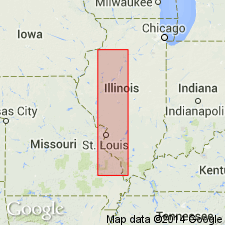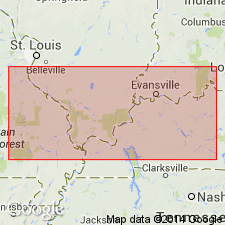
- Usage in publication:
-
- Alto formation
- Modifications:
-
- Named
- Dominant lithology:
-
- Shale
- Limestone
- AAPG geologic province:
-
- Illinois basin
Summary:
Alto formation, named in this report, described as dark siliceous shale and somewhat shaly limestone, 40 to 75 ft thick in Alto Township, Union Co., IL. Unconformably underlies Mountain Glen shale and overlies Lingle limestone. Is thought to represent Portage or Chemung. Age is Late Devonian.
Source: GNU records (USGS DDS-6; Reston GNULEX).

- Usage in publication:
-
- Alto Formation
- Modifications:
-
- Age modified
- Overview
- AAPG geologic province:
-
- Illinois basin
Summary:
Age of Alto Formation not precisely determined but thought to be late Middle Devonian (late Givetian) to earliest Late Devonian (early Frasnian) based on conodonts. Unit is similar to Misenheimer Shale Member of Lingle Formation. No consistent basis for dividing Lingle and Alto into separate formations, but generally boundary is based on change in color. Unconformably(?) overlies Lingle Formation; unconformably underlies Sylamore Sandstone or Grassy Creek Shale.
Source: GNU records (USGS DDS-6; Reston GNULEX).
For more information, please contact Nancy Stamm, Geologic Names Committee Secretary.
Asterisk (*) indicates published by U.S. Geological Survey authors.
"No current usage" (†) implies that a name has been abandoned or has fallen into disuse. Former usage and, if known, replacement name given in parentheses ( ).
Slash (/) indicates name conflicts with nomenclatural guidelines (CSN, 1933; ACSN, 1961, 1970; NACSN, 1983, 2005, 2021). May be explained within brackets ([ ]).

